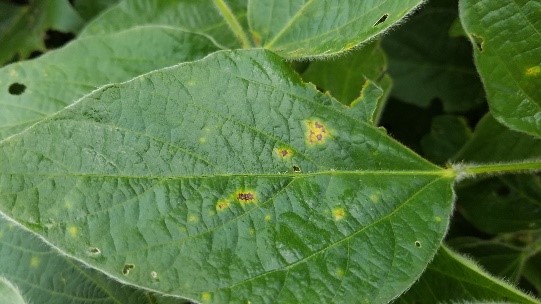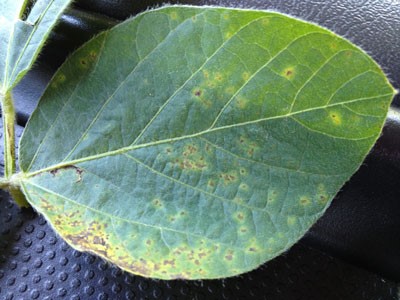In 2018 I received some images on my cell phone. These images were of red crown rot, a soybean disease I had encountered while I was the field crop pathologist at the University of Delaware. The images clearly showed distinctive brick red, pinhead sized “balls” aggregated on the lower stems of the plant. My immediate response to the individual who sent the images was “That’s red crown rot (RCR)- It’s typically a non-issue and routinely found in... Read More →
ILSOYADVISOR POST
Cool and Wet Weather Bring on Bacterial Blight
August 12, 2019
2019 has been an unusual season with a wet spring and very late planting followed by drier weather and outbreaks of diseases and pests. I think this is a year we will be glad to put behind us.
 I have been scouting soybeans on a fungicide project in eastern Nebraska and western Iowa (I live outside Omaha) the last couple weeks. There have seemed to me to be three commonalities across all the soybean fields:
I have been scouting soybeans on a fungicide project in eastern Nebraska and western Iowa (I live outside Omaha) the last couple weeks. There have seemed to me to be three commonalities across all the soybean fields:- Minor leaf feeding (Japanese beetles, caterpillars, bean leaf beetle and others)
- Minor Septoria brown spot at the bottom of the canopy (this was expected)
- Bacterial leaf blight (photo to the right taken by me on July 30, 2019)
Leaf feeding and brown spot were minor and won’t impact yield. However, in some fields I suggested that growers spray to control Japanese beetles. Soybeans can lose up to 20 to 25% of their foliage and not impact yield. While feeding was minor, the extent of the bacterial leaf blight surprised me. The frequent stormy conditions with rains and cooler weather in July probably contributed to the onset of the disease about two thirds up the canopy from soil level. That was an important observation because in all the fields it wasn’t at the bottom or the canopy or at the top but on the same two or three sets of trifoliates off the main stem.
Bacterial blight of soybean isn’t a major disease that impacts yield and in only two fields did I consider the damage of economic consequence. In most instances it was minor with less than 5 to 10% of the leaf area affected and the newest and last trifoliates weren’t affected.

Iowa State University.
The optimum temperature for this disease is around 75oF, which corresponded with the recent cool weather. But as air temperatures climb into the upper 80s and 90s, this disease goes away.
While bacterial blight is a known disease, it isn’t one we watch out for because it is very minor with little to no impact on yield. And, unfortunately, because it is a bacterial disease, today’s fungicides provide no control. Fortunately, warmer air temperatures in the middle of summer can bring this disease to a halt.





Comments
Add new comment